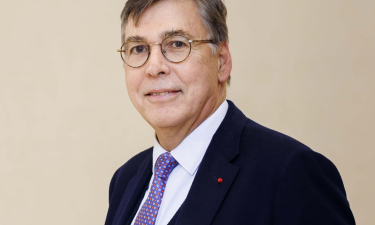- Home
- Deputy governors' speeches
- Unveiling the potential of wholesale CBD...
Unveiling the potential of wholesale CBDC: What insights and prospects?

Denis Beau, First Deputy Governor of the Banque de France
Published on the 3rd of October 2023

Concluding remarks by Denis Beau, First deputy-governor of the Banque de France.
Conference Banque de France - Tuesday 3 October 2023
Introduction
First and foremost, I would like to express my sincere gratitude to all the distinguished speakers for their insightful and educational contributions today. I would also like to thank our audience for participating in this conference, both in person and online.
Our discussions have allowed us to better understand why the financial industry is interested in distributed ledger technology (DLT) and how central banks are exploring wholesale CBDCs. As the Governor pointed out at the opening of this conference, the two pillars for wholesale CBDC that must guide its development are the following: (i) first, to maintain central bank money as the safest settlement asset in a tokenised world; and (ii) second, to improve cross-border payments.
Several key points have caught my attention during these roundtables, and I believe they could guide our actions going forward.
-
With regard to the tokenisation of finance, the public sector must support the private sector more than ever to enable the full potential of DLT while limiting the risks.
Although tokenised financial assets represent only a tiny fraction of the total amount of financial assets, public authorities must keep an eye on their development. Today's roundtable reminded us the potential that DLT can offer to optimise and track transactions, especially for post-trade activities. Panellists also stressed the hurdles that the tokenisation of finance is facing. Come what may, we must be ready to accompany the widespread adoption of such technologies in the coming years. If we do not adapt central bank money to this evolving landscape, meaning if central bank money cannot be used to settle tokenised transactions, industry participants may turn to alternative settlement assets, such as stablecoins. This possibility would jeopardise the progress we have made over the last decades with the settlement of wholesale transactions in central bank money.
Let me share with you my conviction: the tokenisation of finance will only materialise if these new technologies are anticipated, supported and secured by policy-makers and central banks. In short, tokenised central bank money availability and tokenised assets are allies rather than competitors. To enable central bank money availability to evolve and continue to fulfil its pivot role for financial stability, we need to work closely with you, whether you are central bank, financial entity or an international institution. Since 2020, this is the path we have taken at the Banque de France with our experimentation programme, which allows us to refine our understanding of market needs and be prepared to quickly launch an operational wholesale CBDC.
A common observation from our discussions today is that investors and issuers are often intrigued by tokenisation but maybe not yet fully on board. The first generation of experiments have shown that many technological options were feasible for wholesale CBDCs. As some of the panellists clearly put it, the second generation of experiments must be thought to match more specifically the needs of issuers and investors.
To make this happen, the work launched by the Eurosystem to explore new technologies for wholesale central bank money settlement is a unique opportunity to move forward. All the more since it will include trials with real transactions and not only fictitious ones. In the coming days, the Eurosystem will disclose its eligibility criteria. I therefore invite market participants, particularly those in the French and European financial industry, to mobilise now and join us in testing all possible use cases.
We can also encourage the emergence of innovative projects by creating a framework of trust. This framework can only be built if regulation is proactive rather than reactive in response to crises. The European Pilot Regime for market infrastructures based on DLT is a clear demonstration that policy-makers are willing to adapt the regulatory framework to new technologies and to strike a right balance between regulation and innovation. The MiCA regulation which entered into force in June 2023 is also well suited to this purpose. That being said, these regulatory issues are global, which means that domestic regimes should be consistent with each other to avoid regulatory arbitrage. To this end, defining international standards is a necessary step, such as the FSB high-level recommendations on global stablecoin arrangements and on crypto-asset activities. Once defined, their effective enforcement in all jurisdictions matters as much. Therefore, we are committed with international standard bodies to closely monitor their implementation progress.
To conclude on the subject of tokenisation, I would like to highlight one dimension where we still have a lot of work to do: that is the environmental one. As indicated in our report published on 21 July, new DLT infrastructures must be designed with energy efficiency in mind. DLT could also be a catalyst for the development of green finance, by facilitating the issuance and exchange of ESG-criteria assets via smart contracts, for example. The Banque de France has committed, with the development of its own DLT called DL3S, to utilise energy-efficient protocols – specifically, the Proof of Stake, as opposed to the energy-intensive Proof of Work protocol used by Bitcoin. We must now continue our analysis, always keeping in mind the goal of reducing the ecological footprint of the financial industry.
-
Wholesale CBDC could be the catalyst for improving cross-border payments by enabling the build-up of a new international monetary system
With the ongoing work on wholesale CBDCs, central banks are laying the foundations for a new global and multilateral monetary system. It is therefore vital to consider the cross-border issue from the outset and not as an afterthought, as it will be difficult to change these foundations later on. This issue is all the more important as the improvement of cross-border payments is a key focus of the G20. As of today, this essential cog in our global economy suffers from high costs, low speed, limited access and insufficient transparency.
Work on such improvements through wholesale CBDC could take several paths, and I see two major ones on the table today.
One of these paths is the development of common standards and interoperability between wholesale CBDCs and with legacy systems. This coordinated effort on interoperability is essential, to limit the risk that the design of wholesale CBDCs gives its priority to domestic issues over international interoperability. The design of these standards should, as far as possible, precede the launch of any operational wholesale CBDC, in order to avoid two hurdles: (i) the tinkering with an interoperability solution ex post, which could reproduce the current inefficiencies of our RTGS systems which are not natively interoperable, or (ii) a standard imposed through a fait accompli, through the launch of a wholesale CBDC which would set the rules that others would have to follow.
Regarding the question of interoperability, the first thing to consider is the compatibility of wholesale CBDCs with legacy systems, as not all central banks will make the leap at the same time, and some may not even take the plunge. Second, we should consider the compatibility between different wholesale CBDCs. Third, we need to make wholesale CBDCs as "future proof" as possible, and think of them not as final products, but rather as projects that will need to adapt to the rapidly changing environment. This induces a design that facilitates their maintenance, as well as the implementation of new functions.
But if we look at the bigger picture, there might be a second path, being promoted by several international institutions, notably the BIS and the IMF on the development of regional or global platforms. Come what may, this second path must be complementary to the first, since it aims for long-term benefits. The Banque de France welcomes those ambitious ideas and stresses the need for exploratory work on such platforms. They could indeed alleviate the burden of interoperability, as wholesale CBDCs and tokenised assets would be standardised to be easily exchanged directly on these platforms and perform not only payment versus payment but also delivery versus payment transactions. In project Mariana, we have successfully experimented tokenised FX transactions through the exchange of wholesale CBDCs, which explores what automated market makers can offer. I also encourage you to think about these long-term prospects, or even better to explore them.
Conclusion
In conclusion, I believe that today's discussion confirms that we need to continue to explore how DLT could help reshape the financial and monetary system. I invite you to continue to look at the bigger picture, as we have all done today, and to think of wholesale CBDC as a land to be explored, full of unknown possibilities. I trust that this is what will guide our collective efforts in the coming years.
The Banque de France has contributed to this effort through its experimentation programme since 2020, and we will continue along this path. Experimentation is the key to better understanding market needs and meeting industry expectations, and we will not succeed without investors and issuers on board. The European Pilot Regime and the Eurosystem's exploratory work provide excellent opportunities to test the potential of DLT under real-world conditions and to measure how they perform with conventional infrastructures. Beyond technical experts and market participants, I also invite the academics, whether economists or scientists, to join us in that “virgin territory”. Academics are more than welcome to help us assessing and verifying the merits of tokenisation and wholesale CDBCs for improving our financial and monetary systems.
Finally, before I leave you to enjoy the closing cocktail, I would like to remind you that those interested are welcome to attend a demonstration of the Project Mariana downstairs. It will take place below this auditorium in room 2, next to the buffet.
Thank you for your attention, thank you for participating to this conference, and I look forward to our joint and continued efforts to shape tomorrow’s financial landscape.
Updated on the 25th of July 2024